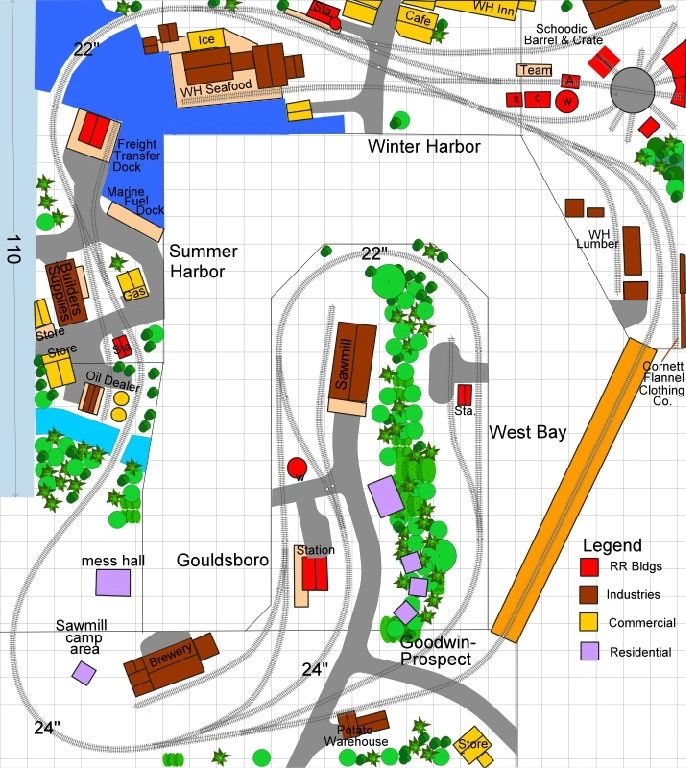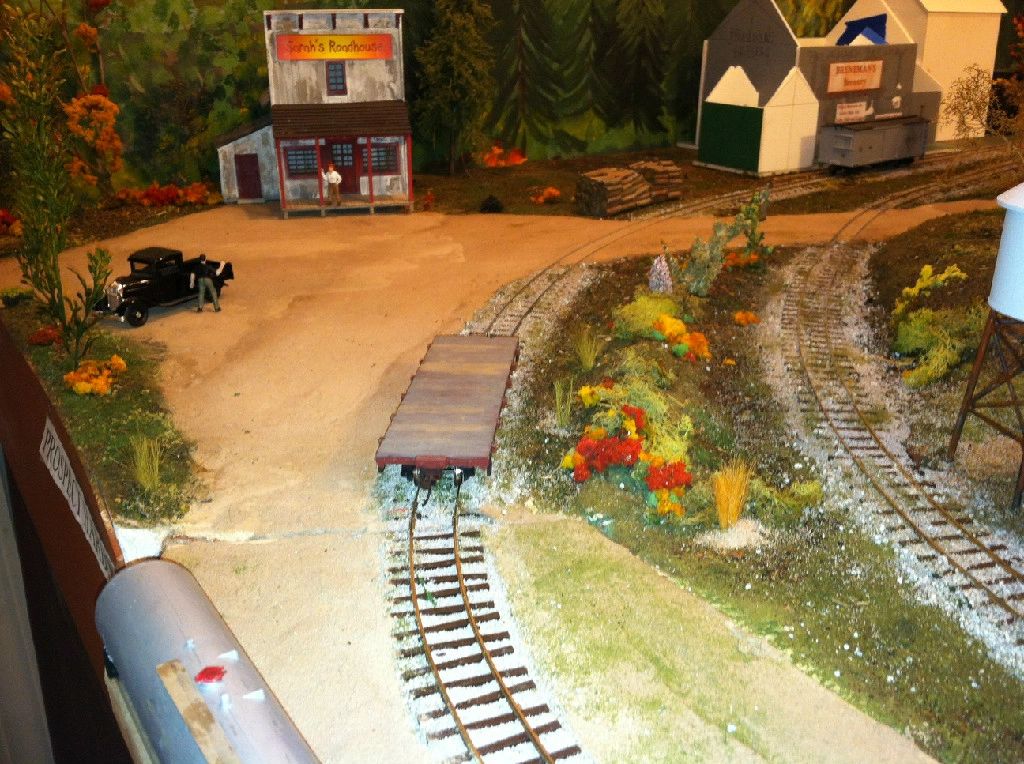The Acadian Coast Eastern
A freelanced 1930's Maine narrow gauge line President and Chief Gandy Dancer: Sandy Eustis
Givens and Druthers:
I wanted the ACE terminus to include a waterfront scene, with a fisherman's co-operative and a couple of lobster boats and other watercraft sitting around, some interesting waterfront clutter here and there, and maybe even a separate dock for a launch serving a posh summer resort on a nearby island – a good excuse to run a bit of passenger equipment every now and then. I thought the other end of the line should probably represent an interchange with a standard gauge line -- hopefully with a standard gauge freight car or two sitting there to show just how small two-foot equipment really was. I definitely wanted a continuous running loop somewhere in the track plan, but also a plausible operating scheme, with a dozen or so active industries to serve, including a couple in a couple of intermediate towns between the waterfront terminus and the standard gauge interchange. And of course I also wanted a branch line to an upstate sawmill, and a decent yard, and an engine service facility.
Compromises and Revisions:
We've owned our current 3 bedroom home since 2007, and I quickly convinced my wife that we really only needed one guest bedroom, so my layout room, the third bedroom, is 14'2" x 12'2". 14' x 12' in O scale is roughly equivalent to 7' x 6' in HO scale, and what you have room for in On30 is not driven primarily by using HO gauge track on fatter ties, but mostly by the footprints of O scale structures and scenic features. So if you're used to thinking in HO scale terms, you'll know right away that a waterfront terminus with an engine terminal, an intermediate town or two, a standard gauge interchange scene, a working branch line to a sawmill, and some room for rural scenery is just not all going to fit in my spare bedroom. To further complicate matters, my wife was none too thrilled with the idea that our grand kids would have no good place to sleep if/when they visited with their mom, and so I had to promise to leave the center of the room open for an inflatable air mattress for at least a couple more years. Since there may be one more move in our future, I also had to promise to make my layout as easily removable as possible -- no nailing of anything into the walls or floor.
I love doodling track plans, and either necessity is the mother of invention, or 14'x12' really is big enough for a one-man On30 empire, because I eventually came up with a track plan that included most of my givens and druthers (see below, on the left side.) Initially (during 2010 and early 2011), the ACE consisted of just the Winter Harbor and Summer Harbor town scenes. Later, I added the engine terminal area, the town of Gouldsboro along the door wall of the room and the removable bridge for continuous running. By early 2012, we realized that visiting grand kids are happy sleeping on air mattresses, but these can be placed anywhere in the house -- not just in their reserved space in the middle of my precious layout room! So I added the stub-ended center peninsula, which included a grade up to a planned sawmill scene on one side and a cassette-based "interchange" on the other. I actually laid all the track on both sides of this peninsula and even completed most of the scenery on the interchange side before I finally accepted the fact that my track plan included a pair of significant problems. First, although the cassette based interchange/staging idea "worked" just fine, I found it both a PITA (pain-in-the-xxx) and an invitation to disaster to have to lift, rotate, and replace a 48" long loaded cassette every time I completed the short run from Winter Harbor to Goodwin. Second, switching in Gouldsboro required me to walk around to the far side of the peninsula just to throw the one turnout at that end of the passing siding or just to couple cars on the slightly curved potato warehouse siding. I thought about adding some sort of remote control device for that turnout, but I'd still be unable to couple cars there.
So in 2013 I ripped up everything beyond the truss bridge leading out of Summer Harbor, and revised half of my track plan completely. Now the ACE runs from Winter Harbor, through Summer Harbor, through Gouldsboro, on a rather tight 22" radius curve around the end of a slightly widened center peninsula, through West Bay (a new rural town scene with a short siding serving a team track), and then back to Winter Harbor. No staging cassettes, no having to leave my train to go to the other side of the peninsula and back again, and the removable bridge is only in place when non-model railroading visitors come over and want to see a train running around and around. The sawmill scene and my already-half-built potato warehouse were relocated to Gouldsboro. To make these improvements, I had to narrow the aisle between Winter Harbor, Summer Harbor and the center peninsula to 24", so two engineers (a full operating crew on the ACE!) can no longer easily pass by each other except in the "harbor corner" between WH and SH. I also had to omit a standard gauge interchange scene entirely, but I do have a more "sincere" and slightly longer main line run, plus some additional industry spots. For me, the bottom line is that my revised ACE track plan is more fun to operate than the original version. The rebuilding process took about 8 months, but I'm satisfied it was modeling time well spent. My original (pre-2013) ACE track plan is on the left below, while my revised plan is on the right.




